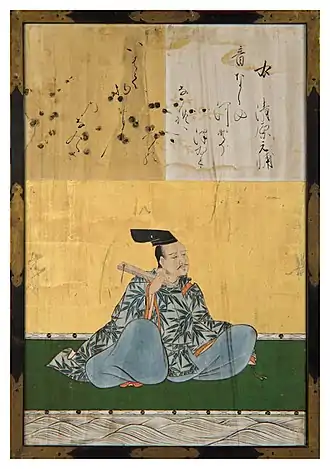Thirty-Six Immortals of Poetry
The Thirty-Six Immortals of Poetry (三十六歌仙, Sanjūrokkasen) are a group of Japanese poets of the Asuka, Nara, and Heian periods selected by Fujiwara no Kintō as exemplars of Japanese poetic ability. The oldest surviving collection of the 36 poets' works is Nishi Honganji Sanju-rokunin Kashu ("Nishi Honganji 36 poets collection") of 1113. Similar groups of Japanese poets include the Kamakura period Nyōbō Sanjūrokkasen (女房三十六歌仙), composed by court ladies exclusively, and the Chūko Sanjūrokkasen (中古三十六歌仙), or Thirty-Six Heian-era Immortals of Poetry, selected by Fujiwara no Norikane (1107–1165). This list superseded an older group called the Six Immortals of Poetry.




Sets of portraits (essentially imaginary) of the group were popular in Japanese painting and later woodblock prints, and often hung in temples.
Kintō's Thirty-Six Immortals of Poetry
- Kakinomoto no Hitomaro
- Ki no Tsurayuki
- Ōshikōchi Mitsune
- Lady Ise
- Ōtomo no Yakamochi
- Yamabe no Akahito
- Ariwara no Narihira
- Henjō
- Sosei
- Ki no Tomonori
- Sarumaru no Taifu
- Ono no Komachi
- Fujiwara no Kanesuke
- Fujiwara no Asatada
- Fujiwara no Atsutada
- Fujiwara no Takamitsu
- Minamoto no Kintada
- Mibu no Tadamine
- Saigū no Nyōgo
- Ōnakatomi no Yorimoto
- Fujiwara no Toshiyuki
- Minamoto no Shigeyuki
- Minamoto no Muneyuki
- Minamoto no Saneakira
- Fujiwara no Kiyotada
- Minamoto no Shitagō
- Fujiwara no Okikaze
- Kiyohara no Motosuke
- Sakanoue no Korenori
- Fujiwara no Motozane
- Ōnakatomi no Yoshinobu
- Fujiwara no Nakafumi
- Taira no Kanemori
- Mibu no Tadami
- Kodai no Kimi
- Nakatsukasa
Thirty-Six Female Immortals of Poetry
Nyōbō Sanjūrokkasen (女房三十六歌仙), composed in the Kamakura period, refers to thirty-six female immortals of poetry:[1]
- Ono no Komachi
- Ise
- Nakatsukasa
- Kishi Joō
- Ukon
- Fujiwara no Michitsuna no Haha
- Uma no Naishi
- Akazome Emon
- Izumi Shikibu
- Kodai no Kimi
- Murasaki Shikibu
- Koshikibu no Naishi
- Ise no Taifu
- Sei Shōnagon
- Daini no Sanmi
- Takashina no Kishi
- Yūshi Naishinnō-ke no Kii
- Sagami
- Shikishi Naishinnō
- Kunai-kyō
- Suō no Naishi
- Fujiwara no Toshinari no Musume
- Taikenmon'in no Horikawa
- Gishūmon'in no Tango
- Kayōmon'in no Echizen
- Nijōin no Sanuki
- Kojijū
- Go-Toba-in no Shimotsuke
- Ben no Naishi
- Gofukakusa-in no shōshō no naishi
- Inpumon'in no Tayū
- Tsuchimikado In no Kosaishō
- Hachijō-in Takakura
- Fujiwara no Chikako
- Shikikenmon'in no Mikushige
- Sōhekimon'in no Shōshō
New Thirty-Six Immortals of Poetry
There are at least two groups of Japanese poets called New Thirty-Six Immortals of Poetry (新三十六歌仙, Shinsanjūrokkasen):
- One selected by Fujiwara no Mototoshi (Heian period)
- One including poets mainly of the Kamakura period; who selected this is unknown.
The term usually refers to the second:[2]
- Emperor Go-Toba
- Emperor Tsuchimikado
- Emperor Juntoku
- Emperor Go-Saga
- Prince Masanari of Rokujō-no-Miya
- Prince Munetaka of Kamakura-no-Miya
- Prince Dōjonyūdō
- Prince Shikishi
- Kujō Yoshitsune
- Kujō Michiie
- Saionji Kintsune
- Koga Michiteru
- Saionji Saneuji
- Minamoto no Sanetomo
- Kujō Motoie
- Fujiwara no Ieyoshi
- Jien
- Gyōi
- Minamoto no Michitomo (Horikawa Michitomo)
- Fujiwara no Sadaie
- Hachijō-in Takakura
- Shunzei's Daughter
- Go-Toba-in Kunaikyō
- Sōheki Mon'in no Shōshō
- Fujiwara no Tameie
- Asukai Masatsune
- Fujiwara no Ietaka
- Fujiwara no Tomoie
- Fujiwara no Ariie
- Hamuro Mitsutoshi
- Fujiwara no Nobuzane
- Minamoto no Tomochika
- Fujiwara no Takasuke
- Minamoto no Ienaga
- Kamo no Chōmei
- Fujiwara no Hideyoshi
Late Classical Thirty-Six Immortals of Poetry
References
- "女房三十六歌仙". www.asahi-net.or.jp.
- "新三十六歌仙(新三十六人撰)". www.asahi-net.or.jp.